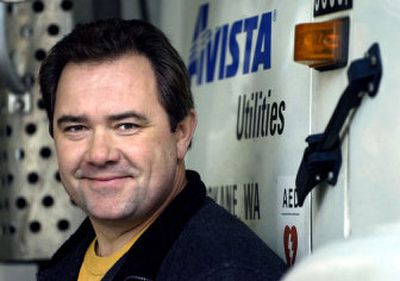Overtime an understatement for utility crews

No one has to remind Hassel Dotson that today is the 10th anniversary of the 1996 ice storm. It’s frozen in his mind like icicles on a full-leafed Norway maple.
“Ice storm is the benchmark of all storms,” said Dotson, a general foreman with the Avista Utilities Spokane line crew since 2001. “When Avista talks about Emergency Operations Plan, ice storm comes up.”
Like the thousands of customers and businesses stifled by the storm of Nov. 19, 1996, utility crews were left with a decade’s worth of stories. But instead of the usual question – “How many days were you without power?” – workers still are asked, “How many days in a row did you work?” and “What did you buy with your overtime pay?”
“I don’t even remember when I stopped,” said Dotson, 30 at the time and a journeyman lineman with Washington Water Power Co., which became Avista Utilities in 1997.
Based in Coeur d’Alene, Dotson remembers it started as a typical winter service dispatch call during a snowstorm the night of Nov. 18. It ended only after several weeks of 18-hour workdays.
At its peak, WWP had 88 line crews and 55 tree-trimming crews at work across the region. It was the largest of eight regional utilities whose customers lost power.
“In the beginning, we didn’t take enough time to realize what we were going to deal with,” Dotson said. “No one could fathom what the damage was going to be.”
The first sign of things to come was at a rest stop near Interstate 90, he said. After working into the early morning at Idaho’s Rose Lake, where the night’s heavy snow had knocked down power lines, Dotson and his co-workers noticed that cars coming from the west were coated with ice, 3 inches thick.
“I’ll never forget coming back across from Fourth of July Pass. At nighttime, you can see the glow from Coeur d’Alene and Spokane Valley, and there was nothing … nothing. And you get down to Hagadone’s golf course (at the Coeur d’Alene Resort), and there was nothing. It was, ‘Wow.’ “
The shocking “wow” factor was triggered by falling trees and branches that knocked out power lines.
Dotson also remembered that the utility company’s initial plan to restore power was as ineffective as wrapping a gauze bandage around a broken leg.
“We tried to react like this was a regular two-, three-day snowstorm,” Dotson said. “And a lot of times, crews worked 40 hours straight with no sleep. … Then we realized what we had, and we started doing the shift work, like 16 to 18 hours, only getting four hours of sleep a night. You were just kind of like a robot.”
According to a WWP overview in January 1997, ice storm lasted between 8:25 a.m. and 5:36 p.m. on Tuesday, Nov. 19. Icing conditions on the company’s delivery systems left more than 100,000 WWP customers, out of 291,000, without power for as little as several hours or as long as 13 days.
Eighty-four of the 104 damaged distribution feeders were in Spokane and Coeur d’Alene. On the first day, 18,000 WWP customers called in. On an average day, 2,500 customers call.
As the week wore on, many customers were up and running, only to have their power go out again. WWP reported 46 percent of its customers experienced more than one outage.
In Spokane, 15,000 customers still were without power eight days after the storm.
“It seemed like we were fighting a never-ending battle,” Dotson said. “The first three, four days, as fast as we were putting lines back up they would come back down.”
Dotson worked the areas around Lake Coeur d’Alene. He remembers 25 miles of wire lines leading to the town of Harrison were on the ground.
“It was overwhelming,” he said. “And you’d also hear the trees snapping off.”
The weeks of labor amounted to lots of overtime. Dotson estimated laborers made between 10 percent and 15 percent more money during the cleanup.
Some workers bought new pickups. Others bought gifts for their wives. Dotson spent his extra pay on his house in Hayden and his young family. His son is 10, and his daughter 12. He also remembers that, despite the frustrations of the workers and customers, most people were understanding and generous.
“I had one lady down the lake chewing on us, saying we were cutting too many trees,” Dotson said. “Everybody else was fabulous. They’d bring us coffee and offer us (a) gratuity, but we couldn’t take the gratuity.”